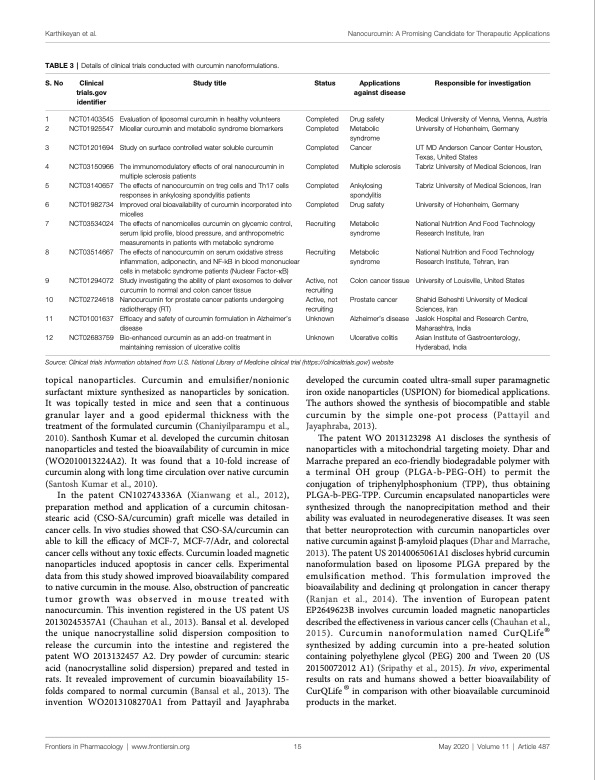
PDF Publication Title:
Text from PDF Page: 015
Karthikeyan et al. Nanocurcumin: A Promising Candidate for Therapeutic Applications TABLE 3 | Details of clinical trials conducted with curcumin nanoformulations. S. No 1 2 3 4 5 6 7 8 9 10 11 12 Clinical trials.gov identifier NCT01403545 NCT01925547 NCT01201694 NCT03150966 NCT03140657 NCT01982734 NCT03534024 NCT03514667 NCT01294072 NCT02724618 NCT01001637 NCT02683759 Study title Evaluation of liposomal curcumin in healthy volunteers Micellar curcumin and metabolic syndrome biomarkers Study on surface controlled water soluble curcumin The immunomodulatory effects of oral nanocurcumin in multiple sclerosis patients The effects of nanocurcumin on treg cells and Th17 cells responses in ankylosing spondylitis patients Improved oral bioavailability of curcumin incorporated into micelles The effects of nanomicelles curcumin on glycemic control, serum lipid profile, blood pressure, and anthropometric measurements in patients with metabolic syndrome The effects of nanocurcumin on serum oxidative stress inflammation, adiponectin, and NF-kB in blood mononuclear cells in metabolic syndrome patients (Nuclear Factor-kB) Study investigating the ability of plant exosomes to deliver curcumin to normal and colon cancer tissue Nanocurcumin for prostate cancer patients undergoing radiotherapy (RT) Efficacy and safety of curcumin formulation in Alzheimer’s disease Bio-enhanced curcumin as an add-on treatment in maintaining remission of ulcerative colitis Status Completed Completed Completed Completed Completed Completed Recruiting Recruiting Active, not recruiting Active, not recruiting Unknown Unknown Applications against disease Drug safety Metabolic syndrome Cancer Multiple sclerosis Ankylosing spondylitis Drug safety Metabolic syndrome Metabolic syndrome Colon cancer tissue Prostate cancer Alzheimer’s disease Ulcerative colitis Responsible for investigation Medical University of Vienna, Vienna, Austria University of Hohenheim, Germany UT MD Anderson Cancer Center Houston, Texas, United States Tabriz University of Medical Sciences, Iran Tabriz University of Medical Sciences, Iran University of Hohenheim, Germany National Nutrition And Food Technology Research Institute, Iran National Nutrition and Food Technology Research Institute, Tehran, Iran University of Louisville, United States Shahid Beheshti University of Medical Sciences, Iran Jaslok Hospital and Research Centre, Maharashtra, India Asian Institute of Gastroenterology, Hyderabad, India Source: Clinical trials information obtained from U.S. National Library of Medicine clinical trial (https://clinicaltrials.gov/) website topical nanoparticles. Curcumin and emulsifier/nonionic surfactant mixture synthesized as nanoparticles by sonication. It was topically tested in mice and seen that a continuous granular layer and a good epidermal thickness with the treatment of the formulated curcumin (Chaniyilparampu et al., 2010). Santhosh Kumar et al. developed the curcumin chitosan nanoparticles and tested the bioavailability of curcumin in mice (WO2010013224A2). It was found that a 10-fold increase of curcumin along with long time circulation over native curcumin (Santosh Kumar et al., 2010). In the patent CN102743336A (Xianwang et al., 2012), preparation method and application of a curcumin chitosan- stearic acid (CSO-SA/curcumin) graft micelle was detailed in cancer cells. In vivo studies showed that CSO-SA/curcumin can able to kill the efficacy of MCF-7, MCF-7/Adr, and colorectal cancer cells without any toxic effects. Curcumin loaded magnetic nanoparticles induced apoptosis in cancer cells. Experimental data from this study showed improved bioavailability compared to native curcumin in the mouse. Also, obstruction of pancreatic tumor growth was observed in mouse treated with nanocurcumin. This invention registered in the US patent US 20130245357A1 (Chauhan et al., 2013). Bansal et al. developed the unique nanocrystalline solid dispersion composition to release the curcumin into the intestine and registered the patent WO 2013132457 A2. Dry powder of curcumin: stearic acid (nanocrystalline solid dispersion) prepared and tested in rats. It revealed improvement of curcumin bioavailability 15- folds compared to normal curcumin (Bansal et al., 2013). The invention WO2013108270A1 from Pattayil and Jayaphraba developed the curcumin coated ultra-small super paramagnetic iron oxide nanoparticles (USPION) for biomedical applications. The authors showed the synthesis of biocompatible and stable curcumin by the simple one-pot process (Pattayil and Jayaphraba, 2013). The patent WO 2013123298 A1 discloses the synthesis of nanoparticles with a mitochondrial targeting moiety. Dhar and Marrache prepared an eco-friendly biodegradable polymer with a terminal OH group (PLGA-b-PEG-OH) to permit the conjugation of triphenylphosphonium (TPP), thus obtaining PLGA-b-PEG-TPP. Curcumin encapsulated nanoparticles were synthesized through the nanoprecipitation method and their ability was evaluated in neurodegenerative diseases. It was seen that better neuroprotection with curcumin nanoparticles over native curcumin against b-amyloid plaques (Dhar and Marrache, 2013). The patent US 20140065061A1 discloses hybrid curcumin nanoformulation based on liposome PLGA prepared by the emulsification method. This formulation improved the bioavailability and declining qt prolongation in cancer therapy (Ranjan et al., 2014). The invention of European patent EP2649623B involves curcumin loaded magnetic nanoparticles described the effectiveness in various cancer cells (Chauhan et al., 2015). Curcumin nanoformulation named CurQLife® synthesized by adding curcumin into a pre-heated solution containing polyethylene glycol (PEG) 200 and Tween 20 (US 20150072012 A1) (Sripathy et al., 2015). In vivo, experimental results on rats and humans showed a better bioavailability of CurQLife ® in comparison with other bioavailable curcuminoid products in the market. Frontiers in Pharmacology | www.frontiersin.org 15 May 2020 | Volume 11 | Article 487PDF Image | Nanocurcumin Promising Candidate for Therapeutic Applications

PDF Search Title:
Nanocurcumin Promising Candidate for Therapeutic ApplicationsOriginal File Name Searched:
fphar-11-00487.pdfDIY PDF Search: Google It | Yahoo | Bing
CO2 Organic Rankine Cycle Experimenter Platform The supercritical CO2 phase change system is both a heat pump and organic rankine cycle which can be used for those purposes and as a supercritical extractor for advanced subcritical and supercritical extraction technology. Uses include producing nanoparticles, precious metal CO2 extraction, lithium battery recycling, and other applications... More Info
Heat Pumps CO2 ORC Heat Pump System Platform More Info
| CONTACT TEL: 608-238-6001 Email: greg@infinityturbine.com | RSS | AMP |